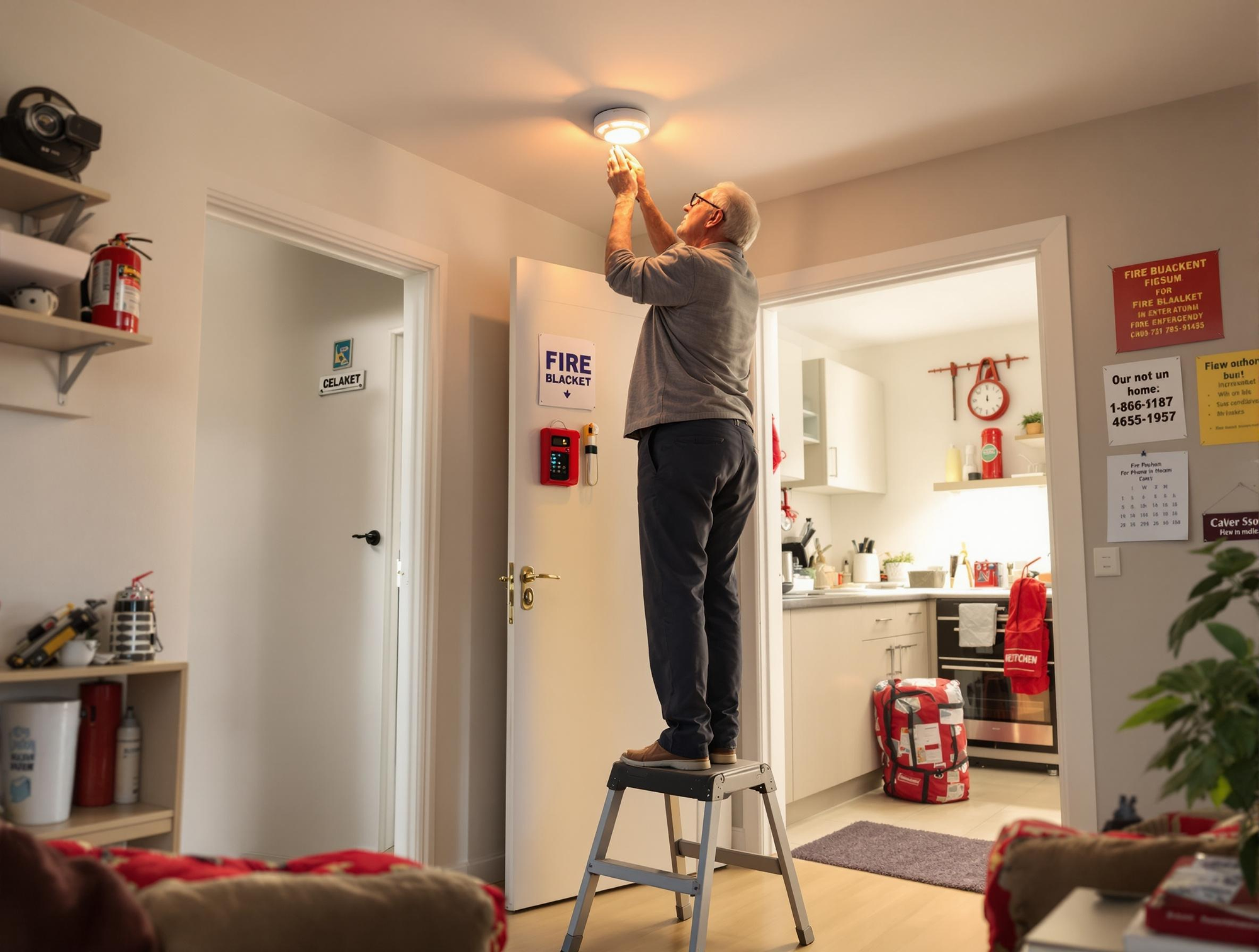Home Fire Safety for Elderly: Prevention and Emergency Planning

House fires pose a significant risk to older adults, with statistics showing that people over 65 are twice as likely to die in home fires compared to younger adults. Age-related changes in mobility, hearing, vision, and cognitive function can increase both fire risks and escape challenges. However, with proper prevention measures and emergency planning, these risks can be dramatically reduced. This comprehensive guide provides essential fire safety information specifically tailored for elderly individuals and their families.
Understanding Fire Risks for Older Adults
Why Elderly People Face Higher Fire Risks
Physical Changes That Increase Risk:
Reduced mobility: Slower movement and difficulty with stairs
Hearing impairment: May not hear smoke alarms quickly
Vision problems: Difficulty seeing hazards or navigating in smoke
Medication effects: Some medications cause drowsiness or confusion
Slower reaction times: Delayed response to fire emergencies
Lifestyle Factors:
Cooking habits: Increased reliance on cooking for meals
Heating needs: Greater use of heating appliances
Smoking: Higher rates among older generations
Electrical equipment: Older appliances and electrical systems
Medication routines: Potential for leaving appliances on
Common Fire Causes in Elderly Homes
Leading Causes:
Cooking accidents (leading cause - 50% of home fires)
Heating equipment (space heaters, fireplaces)
Electrical problems (faulty wiring, overloaded circuits)
Smoking materials (cigarettes, pipes)
Candles and open flames
Kitchen Fire Prevention
Cooking Safety Measures
Safe Cooking Practices:
Stay in the kitchen while cooking, especially when frying or grilling
Use timers for all cooking activities
Keep cooking areas clean and free from grease buildup
Turn pot handles inward to prevent accidental contact
Wear close-fitting clothing while cooking
Equipment Safety:
Check appliances regularly for wear and damage
Clean ovens and hobs to prevent grease fires
Test smoke alarms monthly near kitchen areas
Keep fire extinguisher easily accessible in kitchen
Install automatic shut-off devices for gas appliances
What to Do If a Cooking Fire Starts:
For oven fires: Turn off heat and keep door closed
For stovetop fires: Turn off heat, cover with lid if safe to do so
For grease fires: Never use water - use baking soda or fire extinguisher
If fire spreads: Leave immediately and call 999
Kitchen Fire Prevention Checklist
Daily Habits:
✓ Clean up spills and grease immediately
✓ Check that all appliances are turned off before leaving kitchen
✓ Keep tea towels and paper away from heat sources
✓ Ensure good ventilation while cooking
✓ Keep fire blanket within easy reach
Weekly Maintenance:
✓ Clean oven, hob, and extractor fan
✓ Check electrical cords for damage
✓ Test smoke alarm batteries
✓ Clear clutter from cooking areas
✓ Check gas connections for leaks
Heating Safety
Space Heater Safety
Safe Use Guidelines:
Maintain 3-foot clearance around all sides of heaters
Use only certified heaters with automatic shut-off features
Never leave unattended or use while sleeping
Plug directly into wall outlets - avoid extension cords
Place on stable, level surfaces away from foot traffic
Types of Heaters and Safety Considerations:
Electric heaters: Look for tip-over protection and overheating shut-off
Gas heaters: Ensure proper ventilation and carbon monoxide detection
Oil-filled radiators: Generally safer but still require clearance
Ceramic heaters: Often have better safety features
Central Heating Safety
Annual Maintenance:
Professional boiler service by Gas Safe registered engineer
Chimney cleaning and inspection if using fireplace
Heating system check including radiators and pipes
Carbon monoxide detector testing near gas appliances
Warning Signs to Address:
Strange smells from heating equipment
Yellow or orange flames (should be blue)
Soot marks around appliances
Increased condensation on windows
Pilot lights that frequently go out
Fireplace and Wood Stove Safety
Before Each Use:
Inspect chimney and flue for blockages
Check fireplace screen for damage
Ensure damper opens properly
Keep fire tools nearby
Have fire extinguisher accessible
Safe Burning Practices:
Use only seasoned hardwood
Never burn trash, cardboard, or treated wood
Keep fires small and manageable
Never leave fire unattended
Ensure fire is completely extinguished before leaving
Electrical Fire Prevention
Identifying Electrical Hazards
Warning Signs of Electrical Problems:
Flickering or dimming lights
Frequent blown fuses or tripped breakers
Warm or hot electrical outlets
Burning smell from electrical equipment
Sparks from outlets or switches
Mild electrical shocks from appliances
Common Electrical Fire Causes:
Overloaded circuits from too many appliances
Damaged electrical cords with exposed wires
Old or faulty wiring in older homes
Improper use of extension cords
Defective electrical appliances
Electrical Safety Measures
Safe Electrical Practices:
Avoid overloading outlets - use one high-wattage appliance per outlet
Replace damaged cords immediately - never use tape to repair
Unplug appliances when not in use to prevent electrical fires
Use surge protectors for valuable electronics
Have electrical systems inspected every 10 years by qualified electrician
Extension Cord Safety:
Use temporarily only - not as permanent solutions
Choose appropriate rating for appliance wattage
Inspect regularly for damage or wear
Never run under carpets or through doorways
Unplug when not in use
Appliance Safety
Regular Appliance Maintenance:
Clean lint from tumble dryer after every use
Check washing machine hoses for cracks or bulges
Inspect electrical cords monthly for damage
Replace old appliances that frequently malfunction
Follow manufacturer's maintenance guidelines
Signs an Appliance Needs Replacement:
Frequent electrical problems
Unusual noises or vibrations
Overheating during normal use
Age exceeding manufacturer's recommended lifespan
Repeated repair needs
Smoking Safety
Safe Smoking Practices
If You Smoke:
Never smoke in bed or when drowsy
Use deep, wide ashtrays that won't tip over
Ensure cigarettes are completely extinguished before disposal
Never smoke around oxygen equipment
Keep smoking materials away from flammable items
Disposal Safety:
Wet cigarette butts before throwing away
Use metal containers for ash disposal
Never empty ashtrays into bins with other rubbish
Check furniture and bedding for dropped cigarettes
Wait several hours before disposing of smoking materials
Alternatives and Cessation Support
Safer Alternatives:
E-cigarettes (though not risk-free, generally safer for fire prevention)
Nicotine replacement therapy (patches, gum, lozenges)
Prescription cessation aids (consult with GP)
Cessation Resources:
NHS Smokefree helpline: 0300 123 1044
Local stop smoking services through GP or pharmacy
Online support through NHS Smokefree website
Support groups in community centres
Smoke Alarm Systems
Types of Smoke Alarms
Ionisation Alarms:
Best for: Fast-flaming fires
Response time: Quick to detect small particles
Placement: Ideal for hallways and bedrooms
Considerations: May have more false alarms from cooking
Photoelectric Alarms:
Best for: Slow-burning, smouldering fires
Response time: Better for detecting larger particles
Placement: Good for near kitchens and living areas
Considerations: Less prone to false alarms
Dual-Sensor Alarms:
Best option: Combines both technologies
Comprehensive protection for all fire types
Recommended by fire safety experts
Higher cost but better overall protection
Smoke Alarm Placement and Maintenance
Optimal Placement:
Every bedroom and outside sleeping areas
Every level of the home including basement
Kitchen areas (but not directly above cooking appliances)
Living rooms and family rooms
Hallways and stairwells
Installation Guidelines:
Mount on ceiling or high on walls
Avoid corners where air doesn't circulate well
Keep away from vents that might blow smoke away
Install at least 10 feet from cooking appliances
Follow manufacturer's spacing recommendations
Monthly Maintenance:
Test all alarms using test button
Clean with vacuum to remove dust and debris
Check battery levels in battery-powered units
Replace batteries annually or when chirping
Replace entire units every 10 years
Special Considerations for Elderly Users
Hearing-Impaired Solutions:
Louder alarms (85+ decibels)
Strobe light alarms for visual notification
Vibrating bed shakers for nighttime alerts
Interconnected systems that sound throughout home
Easy Maintenance Options:
10-year sealed battery alarms reduce maintenance needs
Hardwired alarms with battery backup
Smart alarms that send alerts to family members
Professional installation and maintenance services
Emergency Planning and Escape Routes
Creating a Fire Escape Plan
Essential Elements:
Two escape routes from every room
Primary route: Usually through doorway
Secondary route: Window or alternative door
Meeting place outside and away from house
Emergency contact information readily available
Special Considerations for Elderly:
Mobility limitations: Plan routes that accommodate walking aids
Hearing impairment: Visual cues and vibrating alerts
Medication needs: Keep essential medications accessible
Assistance requirements: Identify who can help during evacuation
Escape Route Planning
Bedroom Escape:
Primary route: Through bedroom door to main exit
Secondary route: Through window if ground floor or with escape ladder
Keep routes clear of furniture and clutter
Practice routes regularly, including in darkness
Consider mobility aids needed for evacuation
Living Area Escape:
Multiple exit options from main living spaces
Clear pathways to all exits
Key locations easily accessible near exits
Emergency lighting along escape routes
Alternative routes if primary path is blocked
Emergency Supplies and Equipment
Essential Emergency Items:
Torch with extra batteries in each bedroom
Emergency phone numbers by each telephone
House keys near main exits
Emergency medication in grab bag
Warm clothing easily accessible
Fire Safety Equipment:
Fire extinguishers in kitchen and garage
Fire blankets for kitchen use
Escape ladders for upper floors if applicable
Emergency lighting that activates during power outages
First aid supplies for minor burns or injuries
What to Do During a Fire Emergency
Immediate Response Steps
If You Discover a Fire:
Alert everyone in the house immediately
Call 999 as soon as you're safely outside
Leave immediately - don't try to fight large fires
Close doors behind you to slow fire spread
Meet at designated location outside
If Trapped by Fire:
Close door between you and fire
Seal gaps around door with towels or clothing
Signal for help from window
Call 999 and tell them your location
Stay low to avoid smoke inhalation
Smoke Safety
Smoke Inhalation Prevention:
Stay low - crawl if necessary as smoke rises
Cover nose and mouth with cloth if possible
Test doors with back of hand before opening
Don't open hot doors - find alternative route
Get outside quickly - don't stop for belongings
If Clothing Catches Fire:
Stop, drop, and roll to smother flames
Cover face with hands to protect airways
Roll back and forth until flames are out
Cool burns with water once flames are extinguished
Seek immediate medical attention
After a Fire: Recovery and Prevention
Immediate Post-Fire Actions
Safety First:
Don't enter until fire service declares it safe
Beware of structural damage and falling debris
Watch for hot spots that could reignite
Avoid electrical hazards from damaged wiring
Document damage with photographs for insurance
Essential Contacts:
Insurance company to report claim
Local council for temporary housing assistance
Utility companies to disconnect damaged services
Restoration services for cleanup and repairs
Family and friends for support and temporary accommodation
Learning from Fire Incidents
Post-Fire Assessment:
Identify fire cause to prevent recurrence
Review escape plan effectiveness
Assess smoke alarm performance
Evaluate emergency response
Update fire prevention measures
Improvements to Consider:
Additional smoke alarms in previously unprotected areas
Upgraded fire safety equipment
Professional fire safety assessment
Enhanced emergency planning
Family fire safety education
Professional Fire Safety Services
Fire Safety Assessments
Professional Services Available:
Home fire safety checks by local fire service
Electrical safety inspections by qualified electricians
Gas safety checks by Gas Safe registered engineers
Chimney inspections by certified chimney sweeps
Security and safety assessments by local authorities
What Assessments Include:
Smoke alarm testing and placement
Escape route evaluation
Fire hazard identification
Safety equipment recommendations
Personalised fire safety advice
Installation and Maintenance Services
Professional Installation:
Hardwired smoke alarm systems
Fire suppression systems for high-risk areas
Emergency lighting systems
Security and fire monitoring systems
Accessibility modifications for escape routes
Ongoing Maintenance:
Annual safety inspections
Smoke alarm battery replacement
Fire extinguisher servicing
Heating system maintenance
Electrical system updates
Financial Assistance and Resources
Fire Safety Grants and Support
Local Authority Support:
Free smoke alarms for eligible residents
Home safety checks by fire service
Disabled facilities grants for accessibility improvements
Energy efficiency grants that may include safety upgrades
Emergency assistance for fire safety equipment

Comments